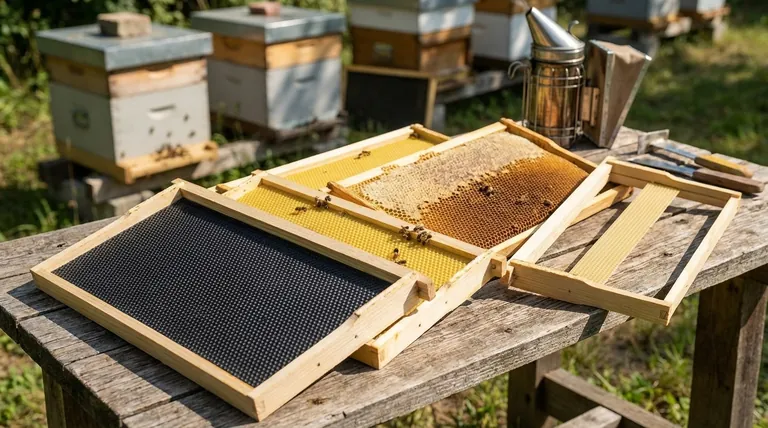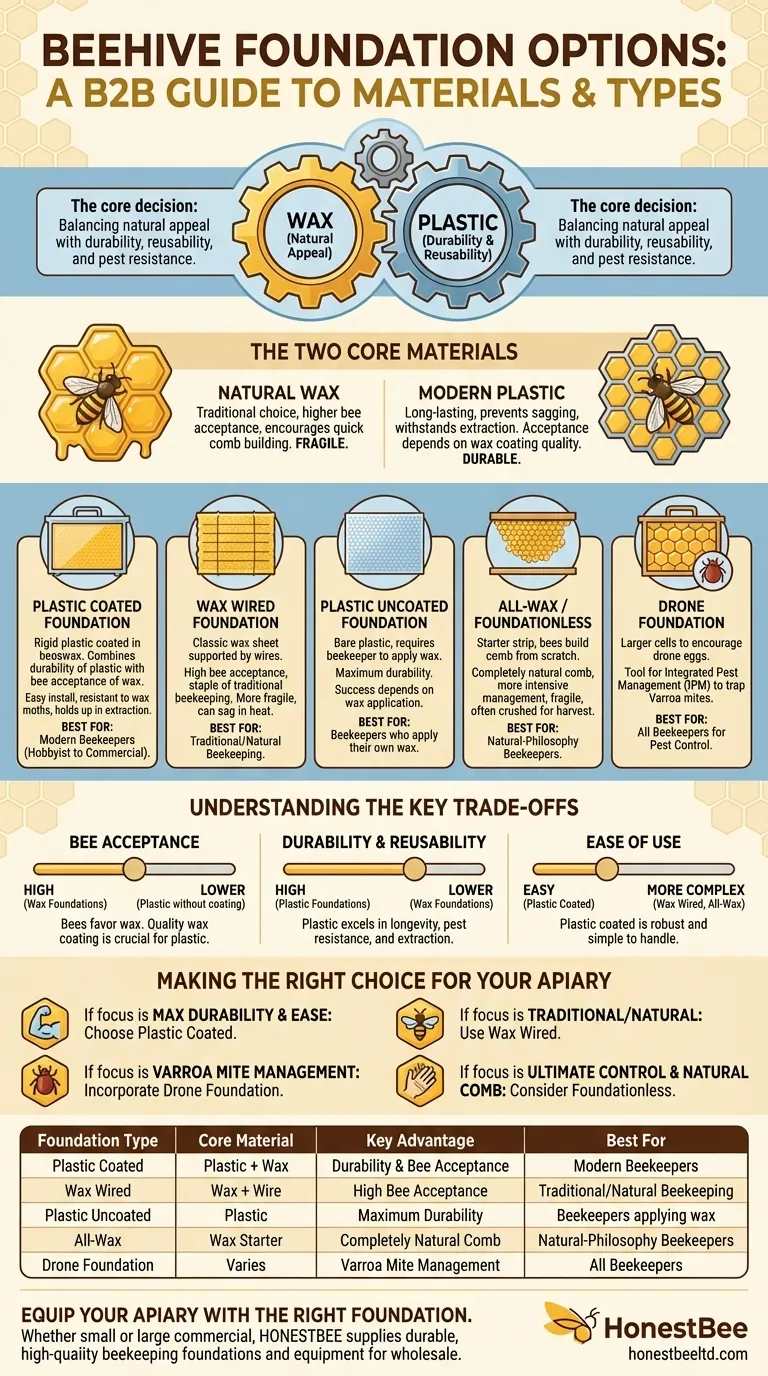The primary types of beehive foundation are categorized by their material and purpose, including plastic uncoated, plastic coated, wax wired, all-wax, and specialized drone foundations. Each option provides a template for bees to build their comb, but they differ significantly in durability, bee acceptance, and the beekeeper's management style.
The core decision in choosing a foundation is balancing the natural appeal and high acceptance of wax with the durability, reusability, and pest resistance of plastic. There is no single "best" option; the right choice depends entirely on your beekeeping goals and philosophy.

The Two Core Materials: Wax vs. Plastic
Understanding the fundamental difference between wax and plastic is the first step in selecting the right foundation for your hives. These two materials dictate nearly all the trade-offs you will make.
The Appeal of Natural Wax
Wax foundations are the traditional choice and are generally accepted more readily by bees. They offer the most natural environment for the colony to draw out honeycomb.
These foundations smell and feel natural to the bees, which can encourage them to begin building comb more quickly. The primary downside is their relative fragility.
The Durability of Modern Plastic
Plastic foundations are a modern innovation designed for longevity and ease of use. Their rigid structure prevents sagging in high heat and withstands the force of honey extraction far better than wax.
While incredibly durable and reusable, their acceptance by bees depends heavily on the quality and thickness of the wax coating applied to their surface.
A Detailed Look at Each Foundation Type
Each type of foundation offers a specific set of advantages and is suited for different beekeeping practices.
Plastic Coated Foundation
This is arguably the most popular choice for modern beekeepers, from hobbyists to commercial operators. It consists of a rigid plastic sheet coated in a layer of beeswax.
This option combines the durability and longevity of plastic with the bee acceptance of a wax surface. It is easy to install, resistant to wax moths, and holds up exceptionally well during honey extraction.
Wax Wired Foundation
The classic foundation, this type is made from a sheet of beeswax embedded with vertical wires for structural support. It is highly accepted by bees and is a staple of traditional beekeeping.
While bees take to it readily, it is more fragile than plastic. It can sag in high temperatures and is more susceptible to damage during handling and extraction.
Plastic Uncoated Foundation
This is a bare plastic sheet with the hexagonal cell pattern molded into it. It offers maximum durability but requires the beekeeper to apply their own coating of melted beeswax.
This is a good choice for beekeepers who want the resilience of plastic but prefer to use wax from their own hives. Success depends entirely on applying a sufficient and even coat of wax.
All-Wax Foundation
For beekeepers prioritizing a completely natural approach, all-wax (or "foundationless") frames are an option. Here, you provide a starter strip of wood or wax, and the bees build their entire comb from scratch.
This method produces beautiful, natural comb but requires more intensive management to ensure bees build straight. The resulting comb is extremely fragile and often must be crushed and strained for honey harvest rather than extracted.
The Special Case: Drone Foundation
This is not a standard foundation for brood or honey. Drone foundation has larger cell patterns designed to encourage the queen to lay drone (male bee) eggs.
Its primary purpose is as a tool for Integrated Pest Management (IPM). Varroa mites prefer to reproduce in drone cells; by removing the capped drone comb, beekeepers can trap and remove a significant number of mites from the hive.
Understanding the Key Trade-offs
Choosing a foundation involves weighing convenience against natural purity and durability against initial bee acceptance.
Bee Acceptance
Bees will almost always accept wax foundations more quickly and enthusiastically than plastic ones. A thick, high-quality wax coating on plastic foundations is crucial to bridge this gap.
Durability and Reusability
Plastic foundations are the clear winner in terms of durability. They can be scraped clean and reused for many years, resist pests like wax moths, and will not break apart in a honey extractor.
Ease of Use for the Beekeeper
For beginners, plastic coated foundations are often the easiest to handle. They snap into frames easily and are robust enough to withstand mistakes. Wired wax can be more delicate to install and manage.
Making the Right Choice for Your Apiary
Your specific goals should guide your decision.
- If your primary focus is maximum durability and ease of use: Choose plastic coated foundation for its longevity and simple handling.
- If your primary focus is a more traditional or natural approach: Use wax wired foundation for its high bee acceptance and natural material.
- If your primary focus is proactive Varroa mite management: Incorporate one or two frames of drone foundation into your brood boxes as part of your IPM strategy.
- If your primary focus is ultimate control and natural comb: Consider foundationless frames, but be prepared for more intensive hive management.
Ultimately, selecting the right foundation is about aligning your equipment with your personal beekeeping philosophy and management style.
Summary Table:
| Foundation Type | Core Material | Key Advantage | Best For |
|---|---|---|---|
| Plastic Coated | Plastic + Wax | Durability & Bee Acceptance | Modern Beekeepers (Hobbyist to Commercial) |
| Wax Wired | Wax + Wire | High Bee Acceptance | Traditional/Natural Beekeeping |
| Plastic Uncoated | Plastic | Maximum Durability | Beekeepers who apply their own wax |
| All-Wax/Foundationless | Wax Starter | Completely Natural Comb | Natural-Philosophy Beekeepers |
| Drone Foundation | Varies | Varroa Mite Management (IPM) | All Beekeepers for Pest Control |
Equip Your Apiary with the Right Foundation
Choosing the correct foundation is critical for hive health and productivity. Whether you manage a small backyard apiary or a large commercial operation, HONESTBEE supplies the durable, high-quality beekeeping foundations and equipment you need.
We provide wholesale-focused solutions for commercial apiaries and beekeeping equipment distributors, ensuring you get the right tools for your specific management style and goals.
Let our expertise guide your equipment choices. Contact HONESTBEE today to discuss your foundation needs and place your wholesale order!
Visual Guide

Related Products
- Food Grade Plastic bee Foundation for Bee Frames
- Manual Beeswax Comb Foundation Machine Wax Foundation Mill Embossing Machine
- Notebook Style Beeswax Foundation Mould Wax Foundation Mold
- Beeswax Foundation Sheets Beehive Foundation for Wholesale
- Professional Frame Preparation: The HONESTBEE Electric Wire Embedder
People Also Ask
- What additional step can improve the performance of plastic foundation in the hive? Apply a Generous Coat of Beeswax
- Why is it beneficial to coat plastic foundation with beeswax? Boost Hive Acceptance & Comb Building
- What is a plastic foundation sheet? A Durable, Reusable Hive Management Solution
- Why do commercial beekeepers prefer plastic foundation? Durable, Reusable, and Cost-Effective
- How does plastic foundation differ from beeswax foundation? Choose the Best for Your Hive's Success



















